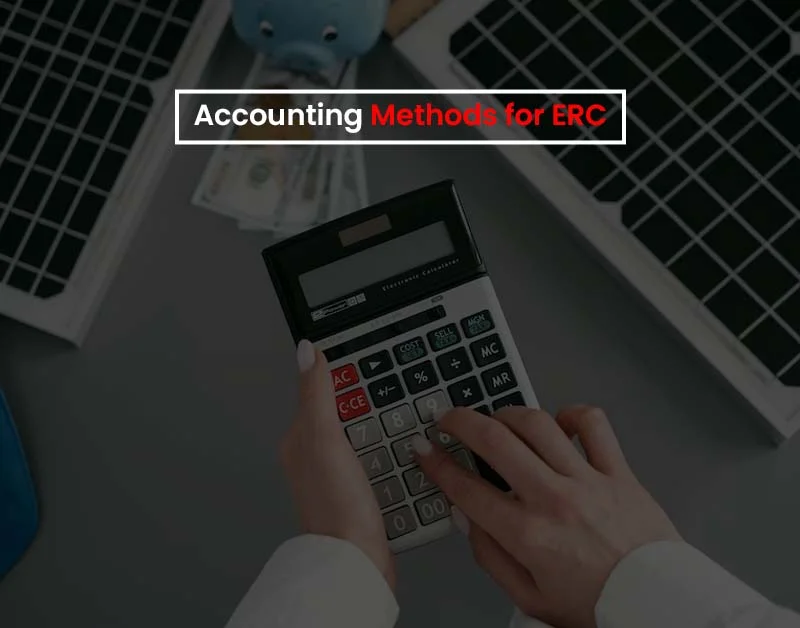Companies that want to portray their financial performance and tax compliance appropriately must include Employee Retention Credit (ERC) in financial statements. The ERC is a beneficial tax break encouraging firms to keep their employees during challenging economic times like the COVID-19 pandemic.
Not only does appropriately disclosing this creditworthiness in financial statements ensure transparency, but it also indicates a dedication to regulatory compliance and financial management.
We cover the processes and considerations for effectively reporting employee retention tax credit 2023 in your financial reports in this guide so that you may achieve transparency and compliance in your economic reporting methods.
Key Takeaways:
- Including ERC in financial statements is essential for transparency and tax compliance.
- It is a crucial tax advantage for keeping staff during difficult economic times.
- To ensure consistency, choose between accrual and cash techniques for ERC accounting.
- ERC employee retention credits 2023 reporting requires proper record-keeping and transparency.
- Keep up with changing rules and seek professional help with ERC reporting.
Employee Retention Credit Reporting Essentials

Employee retention credit (ERC) reporting on financial statements is integral to maintaining transparency and compliance in your company’s financial reporting processes.
The ERC was founded as part of the Coronavirus Aid, Relief, and Economic Security (CARES) Act in 2020 to assist businesses in retaining staff through economic downturns induced by the COVID-19 pandemic. Subsequent legislation, such as the Consolidated Appropriations Act and the American Rescue Plan Act, enlarged and updated it to provide additional relief to businesses.
The following are the key steps and considerations for including the ERC in your financial statements:
Eligibility Determination
- Before reporting the employee tax retention credit, ensure your company is qualified to receive it. Eligibility conditions may differ based on the tax year and legislation in effect.
- Determine whether you meet the revenue loss or government shutdown requirements, as these criteria may alter over time.
Record-Keeping
- Keep careful ERC records of your ERC calculations and supporting documentation. This includes payroll information, turnover information, and other essential documents.
Separate Line Item
- In your financial statements, include the ERC as a separate line item. This demonstrates to stakeholders and accountants that the credit differs from other revenue and expenses.
Accounting Treatment
- Depending on your company’s accounting for ERC credit technique (for example, accrual or cash), you may recognize the ERC differently in your financial reports.
- Accrual accounting requires you to record the ERC as income in the period you are entitled, even if you have not received the funds.
- The ERC is recognized in cash accounting when it is received.
Disclosure Notes
- In the footnotes to your financial accounts, include specific ERC information. Include the amount, the tax years, and any applicable legislation.
- Explain any carry-back or carry-forward clauses and any other pertinent information.
Tax Return Reporting
- Ensure the ERC is correctly recorded on your business tax return (for example, Form 941 for quarterly payroll taxes or other related tax forms).
- To minimize problems, ensure that the ERC declared on your tax return matches the amount recorded on your financial statements.
Consult with Professionals
- Given the complexities of tax rules and regulations, it is best to seek the advice of a professional specializing in ERC compliance. They can assist you in understanding the complexities of a proper credit application and reporting.
Auditor Engagement
- Discuss the ERC with your auditors if your company conducts a financial audit. They must understand how you computed and reported the credit to ensure compliance with Generally Accepted Accounting Principles (GAAP).
Update as Regulations Evolve
- Keep updated on any ERC regulation changes and modify your reporting processes accordingly. Tax regulations are subject to continuous change, and compliance is necessary to avoid penalties.
Components of ERC Reporting

New employee retention credit (ERC) reports include several factors to ensure accuracy and tax compliance. These characteristics are critical for financial transparency and accountability. The following is a detailed breakdown of the essential aspects of ERC reporting:
Determining Eligibility
- Ensure your company meets the eligibility requirements before reporting to the employee retention credit. Eligibility often entails demonstrating a decrease in gross receipts or being subjected to partial or total government closure orders.
- Keep track of which tax years you are qualified for the ERC, as eligibility conditions and credit amounts may vary over time.
Calculating the ERC
- Calculate the ERC separately for each eligible quarter or period. The ERC is calculated by assessing your specific scenario’s suitable salary and credit rate.
- Consider the employee retention credit and, if available, the employer’s Social Security tax deferral when computing the total credit amount.
Accurate Documentation
- Maintain comprehensive and accurate ERC records. This includes wage information, income information, government orders, and other documentation required to support your eligibility and credit calculations.
- In the event of a review, detailed documentation is required to validate your ERC request.
Financial Statement Reporting
- In your financial statements, include the ERC as a separate line item. This sets it apart from usual income and spending.
- In the footnotes to your financial accounts, clearly explain the amount of the ERC, the tax year(s) to which it applies, and any relevant legislation authorizing the credit.
Tax Return Reporting
- Make sure that the ERC is correctly reported on your business tax return. You may utilize multiple forms, such as Form 941, for quarterly payroll tax returns, depending on your business structure (for example, sole proprietorship or partnership).
- To avoid conflicts, match the ERC indicated on your tax return with the amount displayed on your financial statements.
Amendments and Adjustments
- Take immediate action if you discover problems or need to change your ERC calculations or reporting. As required, file revised tax returns or adjust your financial statements appropriately.
Footnote Disclosures
- In the footnotes to your financial accounts, include specific ERC information. Details on the credit calculation, any carry-forward or carry-back provisions, and explicit references to tax law may be included.
- The transparency of the information offered assists stakeholders and auditors in understanding how the ERC was presented.
Communication with Auditors
- If your company is being audited, cooperate with your auditors to ensure they have access to all ERC-related information.
- Prepare to explain how you computed and reported the ERC to demonstrate conformity with (Generally Accepted Accounting Principles) GAAP.
Regulatory Updates
- Keep up with changes to ERC regulations as tax laws and eligibility criteria change. To remain compliant, adjust your reporting processes accordingly.
Documentation Retention
- Keep any paperwork related to the ERC for the required period. The retention term may vary depending on tax legislation and any audit risks.
Consulting Professionals
- Consult with tax professionals or accountants specializing in ERC compliance to verify that you adhere to the most recent norms and regulations.
Accounting Standards for ERC – Determining the Appropriate Reporting Framework

Choosing the proper reporting technique for employee retention credit is critical for ensuring accurate ERC financial data and compliance with ERC accounting rules. We will provide thorough information on the applicable accounting for employee retention credit standards and principles that may apply to ERC reports in the sections below:
-
International Accounting Standards (IAS) 20:
IAS 20 specifies how to account for governmental grants and assistance, which may include incentives like the ERC. However, depending on the jurisdiction and the precise type of credit, the applicability of IAS 20 to ERC may differ. Essential factors to consider include:
Recognition Criteria
IAS 20 specifies the criteria for recognizing public subsidies, including whether they are linked to income or capital. Companies must analyze the nature of ERC and whether it fits the IAS 20 recognition criteria to determine if it should be recognized in profit or loss.
Timing of Recognition
IAS 20 specifies when government grants should be acknowledged, generally when there is reasonable assurance that the grant’s criteria are met. This can affect when a corporation recognizes ERC as revenue.
Presentation
IAS 20 demands certain disclosures about government grants, such as their type, timing, and terms. Depending on their accounting for ERTC practices, companies must disclose ERC in their financial statements as revenue or as a reduction of connected expenses.
-
FASB ASC 958-605:
FASB ASC 958-605 broadly relates to not-for-profit organizations, including specific tax-exempt organizations. Companies must consider the following factors when reporting the ERC under this accounting standard:
Revenue Recognition
For tax-exempt entities, ERC can be considered income. Organizations must determine if ERC should be recognized as revenue under this standard and, if so, when.
Presentation
Entities subject to this standard shall report the ERC in line with FASB ASC 958-605 guidance. Specific presentation and disclosure requirements may apply.
-
FASB ASC 450-30:
FASB ASC 450-30 deals with prospective gains and advises on their recognition and disclosure, including the ERC. Essential factors to consider include:
Recognition Criteria
Contingent gains, such as ERC, are recognized when their realization is likely, and the amount can be predicted relatively. Before opting to recognize the ERC, companies should analyze the chance of accomplishing it as well as the accuracy of the estimate.
Disclosure
ASC 450-30 disclosure rules compel companies to include information about earnings in their financial statements. Companies must disclose the ERC’s nature and scope and any risks involved with its completion.
-
FASB ASC 832:
FASB ASC 832 broadly addresses foreign currency and translation challenges. Although not directly related to the ERC, it may be relevant if your company operates worldwide and gets ERC-related funds in foreign currency. Essential factors to consider include:
Foreign Currency Transactions
FASB ASC 832 provides guidelines on converting foreign currency transactions to your reporting currency if your ERC is received in a foreign currency.
Foreign Exchange Gains or Losses
Any foreign exchange gain or loss related to the ERC must be appropriately accounted for and disclosed in your financial statements.
Accounting Methods for ERC

How you record the Employee Retention Credit (ERC) can significantly influence your financial statements and tax returns. Businesses can utilize one of two ERC accounting systems: the accrual or cash methods. Each approach works as follows:
Accrual Method
Revenue and expenses are recorded in accrual accounting when they are earned or spent, regardless of when cash is collected or paid out. The accrual approach is used with ERC, which means that the credit is recorded in the financial accounts when the qualifying criteria are met, even though the money was not received from the government.
For ERC accounting, the accrual technique works as follows:
Recognition of the ERC
The ERC is recorded as income in the reporting period in which you are entitled to the credit under the accrual method. This often corresponds to the quarters in which you meet the eligibility conditions (for example, if your gross earnings decline significantly or you are subject to governmental orders).
Matching with Expenses
You can comply with the accrual principle by offsetting ERC revenue by recognizing the associated expenditures. These are often the qualified salaries and health care plan expenses that are the foundation for the credit calculation.
Financial Statement Presentation
Your yearly reports show the ERC as income, but you must explicitly indicate that this money is tied to the credit and not from usual business activities. Explanatory notes detailing the nature and amount of the ERC can be included.
Tax Return Reporting
When completing your business tax return, include ERC as income based on your financial records.
Even if you have yet to receive the money from the government, the accrual technique ensures that your financial statements reflect the economic substance of the REB as earned. It can provide you with a better understanding of your financial condition during the eligible period.
Cash Method
Revenue and expense are recognized when cash is received or paid under the cash method of accounting. This means that you must declare the credit as income in the reporting period you receive the money from the government.
The cash technique for ERC accounting works as follows:
Recognition of the ERC
When you get the cash payment from the government, you record the ERC as income in your financial accounts. This means that withdrawal timing may differ from the accrual method.
No Matching with Expenses
Unlike the accrual method, the cash technique does not need to compare ERC income to corresponding expenses.
Financial Statement Presentation
When you get the ERC, you declare it as income on your financial statements. It is critical to state unequivocally that this money is tied to the ERC, not normal corporate activities.
Tax Return Reporting
When you file your business tax return, you must also report the ERC as income as soon as you get it, as shown in your financial accounts.
Because it connects revenue recognition with actual cash flows, the cash flow technique may be more straightforward for organizations to apply. It may not, however, present a realistic picture of your financial performance throughout the qualifying period, as this could result in a high revenue recognition requirement.
Expert Solutions: How R&R Agency Can Assist
Let’s Get ERC emerges as an approach to financial help for businesses across the United States in a world where government assistance programs sometimes appear elusive.
With the government spending almost $2.1 trillion to support businesses facing interruption during the difficult years of the COVID-19 pandemic, the Employee Retention Credit (ERC) is a crucial but often ignored resource.
R&R Agency is your reliable partner as you navigate this complex landscape. Our employee retention credit consultant specializes in making the ERC application process as simple as possible so that your company can readily access the financial help it needs.
Discover the solution that clarifies ERC eligibility, streamlines reporting, and guides you step by step through the process. With us, you can unlock ERC’s latent potential and gain the help your business needs to survive in difficult times.
Contact us immediately to learn your qualifications and begin your stress-free ERC journey.
FAQs
ERC can be recorded in accounting using either the accrual or cash approach. Recognize the credit when you qualify, matching it with associated expenses under accrual. When you receive cash from the government, record it under money without expense matching.
Include ERC as income or a decrease of related expenses in your financial statements, depending on your accounting approach. Declare it correctly and include it in your tax return.
The IRS is usually in charge of processing ERC refunds. Check the status of your refund on the IRS website, or contact them if you have any specific questions.
ERC is represented as an income or an expense reduction in your financial accounts, generally as a separate line item. It is also included on your tax return.
The U.S. government funds the ERC through legislation like the CARES Act, Consolidated Appropriations Act, and American Rescue Plan Act.
The ERC is a tax credit that allows eligible employers to claim a percentage of qualified salaries paid to employees during economic hardship, such as the COVID-19 pandemic.
The ERC’s primary goal is to assist businesses and charity organizations affected by the pandemic. Priorities include retaining employees, keeping firms running, and providing financial relief to employers.
Conclusion
The honest financial reporting of the Employee Retention Tax Credit (ERC) is essential for long-term success. The legal approach you use, both accrual and cash, as well as new documentation and transparency, can assist businesses in effectively representing their financial services.
The foundation of an ERC report is financial transparency. In retrospect, the economic results of this report are predicated on the fact that ERC reporting is based on the importance of auditors being informed.



